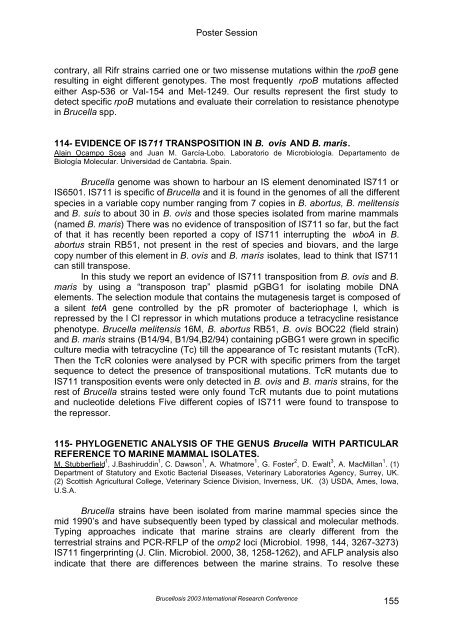Brucellosis 2003 proceedings - PHIDIAS
Brucellosis 2003 proceedings - PHIDIAS
Brucellosis 2003 proceedings - PHIDIAS
You also want an ePaper? Increase the reach of your titles
YUMPU automatically turns print PDFs into web optimized ePapers that Google loves.
Poster Session<br />
contrary, all Rifr strains carried one or two missense mutations within the rpoB gene<br />
resulting in eight different genotypes. The most frequently rpoB mutations affected<br />
either Asp-536 or Val-154 and Met-1249. Our results represent the first study to<br />
detect specific rpoB mutations and evaluate their correlation to resistance phenotype<br />
in Brucella spp.<br />
114- EVIDENCE OF IS711 TRANSPOSITION IN B. ovis AND B. maris.<br />
Alain Ocampo Sosa and Juan M. García-Lobo. Laboratorio de Microbiología. Departamento de<br />
Biología Molecular. Universidad de Cantabria. Spain.<br />
Brucella genome was shown to harbour an IS element denominated IS711 or<br />
IS6501. IS711 is specific of Brucella and it is found in the genomes of all the different<br />
species in a variable copy number ranging from 7 copies in B. abortus, B. melitensis<br />
and B. suis to about 30 in B. ovis and those species isolated from marine mammals<br />
(named B. maris) There was no evidence of transposition of IS711 so far, but the fact<br />
of that it has recently been reported a copy of IS711 interrupting the wboA in B.<br />
abortus strain RB51, not present in the rest of species and biovars, and the large<br />
copy number of this element in B. ovis and B. maris isolates, lead to think that IS711<br />
can still transpose.<br />
In this study we report an evidence of IS711 transposition from B. ovis and B.<br />
maris by using a “transposon trap” plasmid pGBG1 for isolating mobile DNA<br />
elements. The selection module that contains the mutagenesis target is composed of<br />
a silent tetA gene controlled by the pR promoter of bacteriophage l, which is<br />
repressed by the l CI repressor in which mutations produce a tetracycline resistance<br />
phenotype. Brucella melitensis 16M, B. abortus RB51, B. ovis BOC22 (field strain)<br />
and B. maris strains (B14/94, B1/94,B2/94) containing pGBG1 were grown in specific<br />
culture media with tetracycline (Tc) till the appearance of Tc resistant mutants (TcR).<br />
Then the TcR colonies were analysed by PCR with specific primers from the target<br />
sequence to detect the presence of transpositional mutations. TcR mutants due to<br />
IS711 transposition events were only detected in B. ovis and B. maris strains, for the<br />
rest of Brucella strains tested were only found TcR mutants due to point mutations<br />
and nucleotide deletions Five different copies of IS711 were found to transpose to<br />
the repressor.<br />
115- PHYLOGENETIC ANALYSIS OF THE GENUS Brucella WITH PARTICULAR<br />
REFERENCE TO MARINE MAMMAL ISOLATES.<br />
M. Stubberfield 1 , J.Bashiruddin 1 , C. Dawson 1 , A. Whatmore 1 , G. Foster 2 , D. Ewalt 3 , A. MacMillan 1 . (1)<br />
Department of Statutory and Exotic Bacterial Diseases, Veterinary Laboratories Agency, Surrey, UK.<br />
(2) Scottish Agricultural College, Veterinary Science Division, Inverness, UK. (3) USDA, Ames, Iowa,<br />
U.S.A.<br />
Brucella strains have been isolated from marine mammal species since the<br />
mid 1990’s and have subsequently been typed by classical and molecular methods.<br />
Typing approaches indicate that marine strains are clearly different from the<br />
terrestrial strains and PCR-RFLP of the omp2 loci (Microbiol. 1998, 144, 3267-3273)<br />
IS711 fingerprinting (J. Clin. Microbiol. 2000, 38, 1258-1262), and AFLP analysis also<br />
indicate that there are differences between the marine strains. To resolve these<br />
<strong>Brucellosis</strong> <strong>2003</strong> International Research Conference<br />
155
















